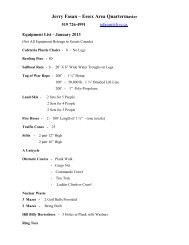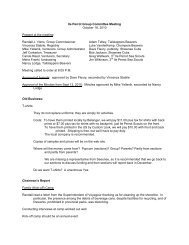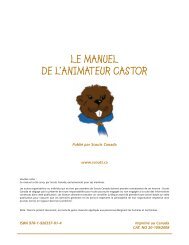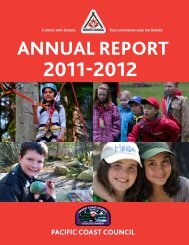Beaver Leader's Handbook - Scouts Canada
Beaver Leader's Handbook - Scouts Canada
Beaver Leader's Handbook - Scouts Canada
Create successful ePaper yourself
Turn your PDF publications into a flip-book with our unique Google optimized e-Paper software.
PURPOSE AND VALUE<br />
Effective planning is the key to providing a program which meets the aims of Scouting. It makes<br />
the difference between a program which offers no meaningful fun, and one that gives a variety<br />
of quality activity and experiences. The <strong>Beaver</strong> program is not simply a weekly recreational<br />
event for children; it’s a well-balanced program that encourages <strong>Beaver</strong>s to:<br />
4 Find examples of God’s love for them and the world<br />
4 Experience and express love and joy<br />
4 Express themselves<br />
4 Be healthy and have good feelings about themselves<br />
4 Develop a sense of belonging and sharing in small group activities<br />
4 Appreciate nature<br />
4 Develop a sense of cooperation through non-competitive activities.<br />
<strong>Scouts</strong> <strong>Canada</strong>’s Program Standards for <strong>Beaver</strong>s (Chapter 3) provides your yardstick for measuring<br />
whether a particular activity idea is appropriate for the program. They’re also the tools for<br />
evaluating the design of the colony programs.<br />
For example, if you choose an activity for a meeting, and after thinking about it in terms of the<br />
Program Standards, find it doesn’t meet any of them, discard it. If, when you look over the activities<br />
you’ve planned, you find one of the Standards hasn’t been met, you can insert activities to<br />
add balance to the program.<br />
SHARING THE PLANNING<br />
In an effort to reinforce the practical and applied benefits of cooperative activity, <strong>Beaver</strong> leaders<br />
use a very obvious shared leadership style. The <strong>Beaver</strong>-aged child is influenced to a great<br />
degree by what we do, how we do it, and how we feel about it. In other words, by the model<br />
we present.<br />
Leaders<br />
Although group decision-making may sometimes be slow, individual burdens are greatly lessened<br />
when responsibility for planning is equally shared. Not only that, but the store of ideas,<br />
resources and contacts is enriched and multiplied each time you work collectively with others.<br />
Be certain to encourage new members to play an equal part in all planning and programming.<br />
<strong>Beaver</strong>s And Keeo<br />
Before we get too carried away with planning, let’s consider two excellent resources.<br />
First and foremost are the <strong>Beaver</strong>s themselves. Because our planning aims to promote and<br />
encourage values children can use throughout life, it’s important to involve your <strong>Beaver</strong>s in the<br />
process. Ask your <strong>Beaver</strong>s what things they like to do. It’s a great opportunity for a tail group<br />
discussion, and to ensure activities remain <strong>Beaver</strong> driven.<br />
Second, make Keeo a member in the planning process. This young person gives much time and<br />
effort to the colony. Recognize this contribution and encourage Keeo’s emerging maturity by<br />
involving the Cub in all idea generating stages.<br />
10-1








